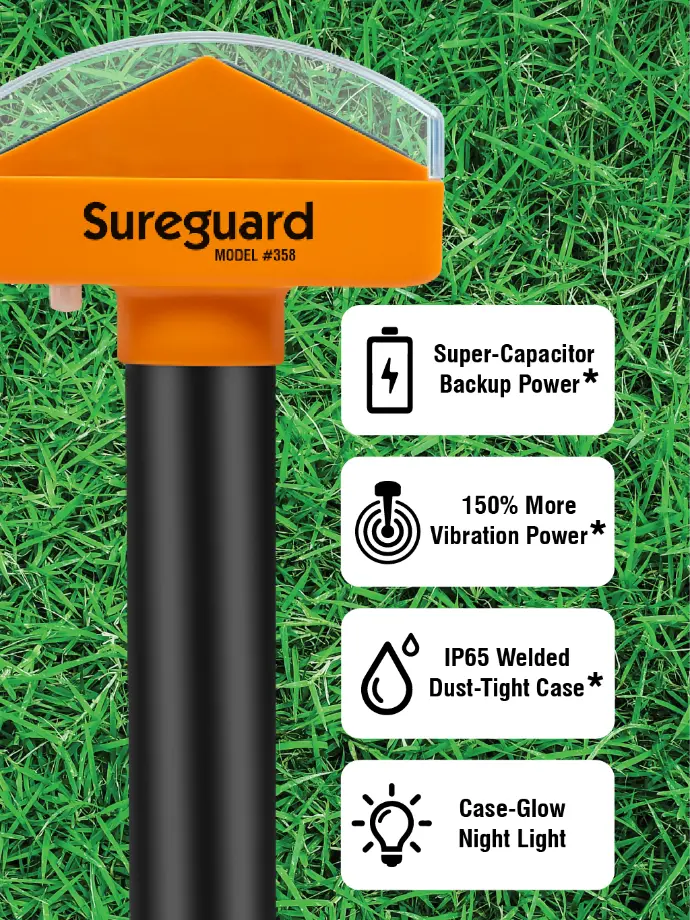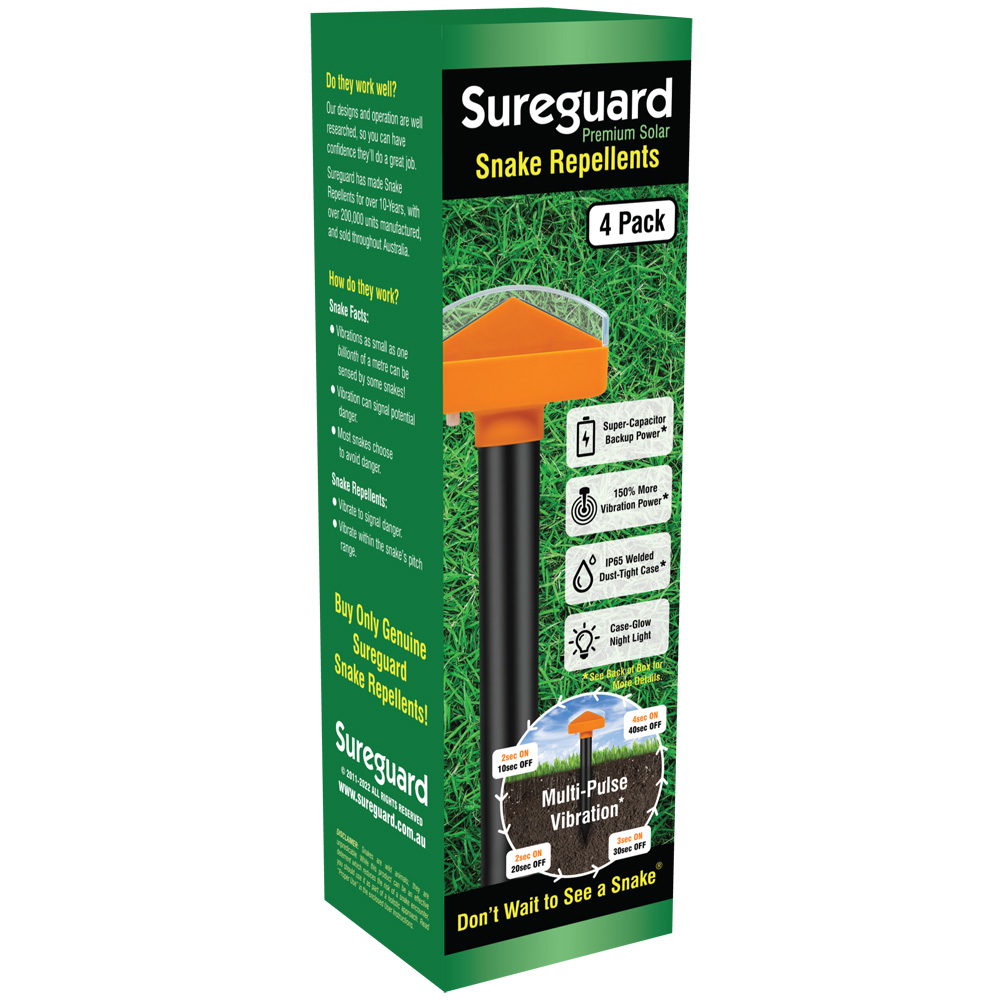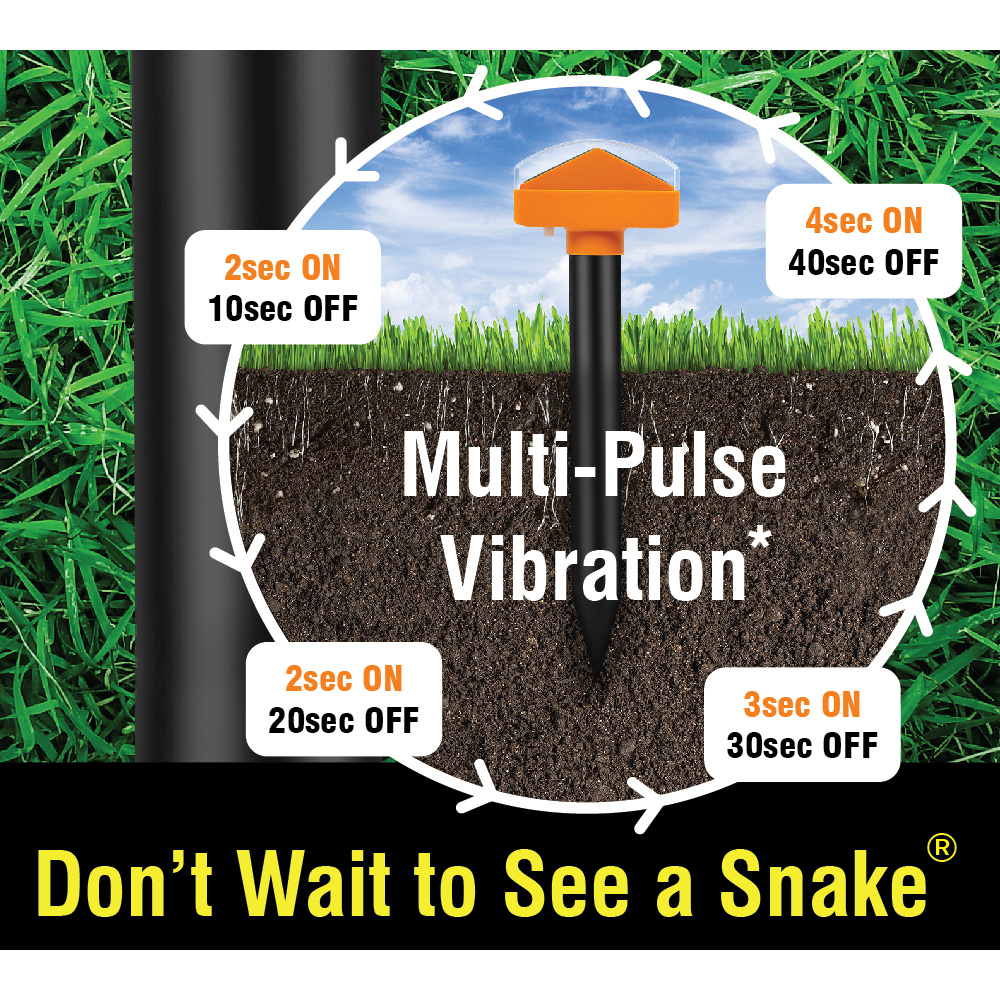Snake Repellents Premium Solar with Multi-Pulse Vibration and Garden Light 4-PACK
Premium Quality and Features.
Don't wait to see a snake!®
Sureguard Snake Repellents have been developed as a deterrent to many kinds of snakes. They emit a pulsing vibration into the surrounding soil. When the snake perceives the vibration as a source of danger most snakes will choose to avoid confrontation. (Similar principle to bushwalkers walking noisily to scare snakes away.)
Don't wait to see a snake!®
Use Snake Deterrents to create avoidance zones
Advanced New Features
- Long-Life Super-Capacitor: Backup power for nights and cloudy weather. Up to 3 weeks of backup power. No batteries required!
- Improved Vibration: 150% more powerful than many other brands. 55% more powerful than our previous premium model.
- 100 Second Multi-Pulse Vibration: Uses a changing pulse pattern that repeats on a 100 second cycle. This is designed to reduce potential desensitisation in snakes.
- Welded Case: Now has an Ingress Protection Rating of IP65 which is widely accepted as "waterproof".
Other Built-in Features
- "Case Glow" LED garden night light.
- ON/OFF Switch.
- Up to about 30m coverage.
For shady areas, please consider this model: Battery Operated Snake Deterrents for Sun & Shade

Do Snake Repellents Really Deter Snakes?
Our customers say they work very well. We encourage you to read the many hundreds of customer reviews for this repellent at the bottom of this page.
Sureguard are so confident about the performance of our products, we have a special Guarantee (see menu top of page). You may install and try the product. If you are not completely satisfied with the results we'll happily refund your money!
There are several factors to consider:
To protect one spot, one snake repellent may be sufficient.
To protect the area immediately around your house, one repellent at each corner could be enough to provide overlapping vibration between adjacent repellents. The best coverage is when the snake repellents are away from the walls, say 5m.
Protecting the whole property is also practical by forming a barrier around your fence line. The repellents are placed no more than 25m apart.
If you have snakes coming from a certain direction, for example, neighbouring grassland, you could simply place the snake repellents along that boundary. The repellent action will transmit under most fences so in this way you keep the snakes off your property at a distance.
Some situations may require more repellents.
Soil types: The 25m apart is a maximum range for most soils, but for sandy soil or soil with a lot of fine stones, you should reduce this to 10m apart.
Hard objects: If you have pathways, you'll need a repellent on both sides because the vibration doesn't pass through hard objects in the ground. This applies to concrete, bitumen, gravel, pavers, etc.
Shallow topsoil: If your topsoil is shallow then reduce the separation between repellents.
Multi-level ground: You'll need snake repellents on both levels where the ground is terraced because the vibration won't travel between levels.
Soil cracks: If the soil is dry and cracked you'll need repellents on both sides because the vibration doesn't cross the gap.
Do Sureguard Snake Repellents repel lizards, eg. Blue Tongues, etc.?
No, they are designed for snakes and there is no evidence of lizards being affected.
Do Sureguard Snake Repellents repel frogs, toads, birds, pets, etc.?
No, they are only designed for snakes.
Can snakes be caught inside the protective boundary?
It
is possible. If you already have snakes living in your garden, you
should consider having them professionally removed before installing the
repellents. (Try searching for: snake catcher, snake removal or snake
handler). Another strategy is to install the repellent centrally, say
around the house area, then week by week move them further away until
you have them all moved to your property boundary.
Can snakes get used to the vibration so it becomes less effective?
Repeated
exposure to the vibration could lessen the deterrent. In psychology,
this is called desensitisation. In practice, this is rare because the
snake moves out of the area. However, take care not to inadvertently
trap the snake in the protected area. For example, one Sureguard
customer had a snake under the slab of her house. She placed the
repellent at the entrance of the hole to repel the snake. The snake did
not come out for weeks, obviously feeling trapped, but eventually
overcome its fear and went past the repellent. The correct installation
would be to wait for the snake to exit the hole and later place the
repellent there before the snake returned.
Do the repellents work on all snakes?
Sureguard
Snake Repellents work on most snakes moving along the ground. A python
moving off a tree onto your aviary won’t be deterred. Similarly, tree
snakes won’t be affected. Juvenile snakes may respond poorly. Sureguard
does not recommend using repellents against the species Acanthophis
antarcticus (Common Death Adder). Unlike other snakes that tend to move
away from human activity, the Death Adder's method of hunting by ambush
means it tends to stay hidden. (Reference: Wikipedia - Acanthophis).
I saw a snake moving off in the direction of a repellent, why?
To
explain this behaviour you need to understand the psychology of how the
product works and a concept in psychology called the “fight or flight
response” (see Wikipedia). When a snake is casually moving through the
environment and starts to detect the vibration, it chooses not to go
there. Perhaps it is dangerous, the snake does not know. Is there an
urgency in the snake’s mind? Not necessarily. If the snake is casually
moving toward the protected area the snake may simply change direction
without you ever knowing it was around. However, when you saw the snake
moving quickly it had likely already detected you and chose to quickly
move away. This is a natural “flight response”. Did it also detect the
repellent? Not necessarily so; the repellents emit a pulsed vibration
every 30 to 60 seconds. Between the pulses, there is nothing to sense.
This would explain the snake’s poor choice of direction.
I found a snake sunning itself on some garden steps. Why wasn’t it repelled?
Carefully
analyse how the snake may have travelled to that point. Remember, the
repellents won’t affect a snake moving on some hard surfaces, e.g.
concrete, pavers, bitumen, etc. For example, Sureguard had a customer
call our technical department for assistance. Repellents had been
installed around the whole back yard but a snake later found its way to
the back door. When we analysed the installation we found a 2m section
of concrete pathway unprotected on the property boundary because it was
not considered worthwhile placing a repellent on this narrow strip. It
was effectively a hole in the boundary which the snake happened to come
through then travel on the concrete to the back door. A repellent had
been used on one side of the concrete pathway but the protection didn’t
extend across to the other side. The solution was to place the repellent
on the other side of the pathway. This solution worked.
I have a snake on my roof, can I place the repellent there?
Sureguard
Snake Repellents have only been designed to repel snakes on the ground.
Do not hang them on the roof or gutter, or on trees or other
structures.
Want a longer warranty cover on your purchase?
Sureguard offers optional 3 year extended warranties.
Customer Reviews
I am a repeat customer. Haven't seen a snake since I put in my new solar powered snake repellers. Always happy with the product and the service. The initial service and following after sales service, not to mention the quality of the repellers, stops me from buying cheaper versions from overseas.
Lynn Maney
Very happy with our snake repellers. We had approx 12 snakes in as many days and have not seen one since installing the repellers!
Stacey
-
All Reviews 25 / 486 {'1': 6, '2': 6, '3': 24, '4': 61, '5': 389}Reviewed byPeter Phillips00Easy to set up.An addition to current means to deter snakes from our back yard. We have a dog and have had a snake in the yard last year. Will also improve our fences. Product is solid and easy to set up. Only been in a week so hoping g for a good result.Read More10 years agoReviewed byLee Powell00So far so good to repel the snakeSince purchasing and installing we have not seen the snake. Hasn’t repelled our lizards or small birds for which I’m gratefulRead More10 years agoReviewed byKahlia Lloyd00So far so goodSolar panel fantasticRead More10 years agoReviewed byPaul Iannuzzelli00So far so goodNo snakesRead More10 years agoReviewed byRush Zhu00No more snake spotted after Sureguard Snake RepellentI recommend Sureguard Snake repellent, as no more snakes spotted in my backyard after installation. Hope it keeps snakes off my property as long as they can.Read More10 years agoReviewed byKosta Bektasovski00150% more vibrationIt has150% higher vibration to keeps snake’s awayRead More10 years agoReviewed byEdward Ogilvie00Ease of useHas a nice light at nightRead More10 years agoReviewed byIan Urquhart00Have them alreadySeems to workRead More10 years agoReviewed byCheryl Allen00Snakes @ chookpenScare snakes awayRead More10 years agoReviewed byLeanne Reeves00To deter a pesky Red Belly Black snake from getting near my home.A very dear friend highly recommended to get these. They work in Qld so should work in Vic 🤞 To deter a pesky red Belly black snake from getting near my home. It can have the paddocks just not my house yard. So I purchased 2 boxes. 8 Sureguard in total.Read More10 years agoReviewed bySarah Campisi00Bought for our puppyHoping to rid of snakesRead More10 years agoReviewed byBarb Newman00Sureguard Snake Repellers Premium SolarGreat product. Easy to install. Highly recommended.Read More10 years agoReviewed byKym McPherson00To repel snakesThis is the 2nd set of sureguard snake repellents I have purchased in the past 3 years I live close to a river and find I trust suregusrd to protect my animals by repelling the snake from our yard .Read More10 years agoReviewed byRussell Barrett00Little rippersRecommendation from friendsRead More10 years agoReviewed byMark Johnston00Repeat userReliability and durabilityRead More10 years agoReviewed byKevin Khuu00Convenient & effectiveConvenient & effectiveRead More10 years agoReviewed byShelley Grace00We’ve used them to before with great successReliable, easy to install. Piece of mind living on a park. Convenient- set and forgot for 12 months - bought 2 packs the solar ones do ensure total perimeter and multi level coverage.Read More10 years agoReviewed byShelley Grace00Super convenient and effectiveEasy installation. Effective. Set and forget.Read More10 years agoReviewed byGail Atkins00Extra peace of mindSolar operation, detailed instructions.Read More10 years agoReviewed byTyson Graham004 pack4 pack makes easier to spread outRead More10 years agoReviewed byJane Ashton00waterproof casing - unlike othersSo far it seems a lot better than competing products, more robustRead More10 years agoReviewed byWilson Stanley00Well made product.Well made product. Vibration doesn’t seem as powerful as the Envirobug ones. Seems more waterproof. Has a plastic main body compare to a steel one on the Envirobugs.Read More10 years agoReviewed byRomani Morath00EffectiveEffective and efficient.Read More10 years agoReviewed byMatt Tibbitts004 pack for the priceSolar chargingRead More10 years agoReviewed byDesmond Hogan00We have snakes in the yardWe have only put them in today 1/1/2025, but friends recommended them to us.Read More10 years ago
Write your review
You must be logged in to post a review.






 Download Snake Repellent User Guide
Download Snake Repellent User Guide























